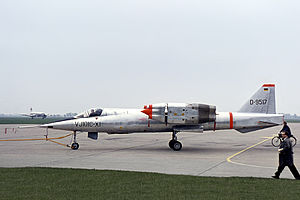EWR VJ 101
| VJ 101 | |
|---|---|
 |
|
| The EWR VJ101C, X-1 prototype, April 1964 | |
| Role | V/STOL fighter |
| Manufacturer | EWR |
| First flight | 10 April 1963 |
| Retired | 1968 |
| Status | Cancelled |
| Number built | 2 |
The EWR VJ 101 was an experimental German jet fighter VTOL tiltjet aircraft. VJ stood for "Versuchsjäger", (German for "Experimental Fighter"). It was to be the basis for a successor to the F-104G Starfighter, but was cancelled in 1968 after a five-year test program, during which two prototype aircraft were built. The VJ 101 was one of the first V/STOL designs to have the potential for eventual Mach 2 flight.
Heinkel and Messerschmitt had developed designs to meet the requirements of VTOL flight and by 1959, the two companies, along with Bölkow, had created a joint venture company called EWR, to build the VJ 101 D. The production VJ 101 D aircraft were to use the Rolls-Royce/MAN Turbo RB153 engine, a turbofan with thrust deflection. Two prototype aircraft, VJ 101 C, were to use the RB145 engine, a turbojet mounted in swivelling nacelles.
The new proposal merged the characteristics of earlier Bölkow, Heinkel and Messerschmitt designs into a sleek, streamlined platform. The VJ 101 C was similar in appearance to the Bell XF-109, both with paired engines in swivelling nacelles at the wingtips. In addition to the wingtip engines, two further lift jets were installed in the fuselage to supplement the main engines in hovering flight.
In order to test the concept, EWR built a test rig called the Wippe (seesaw) in early 1960. The simple device incorporated a rudimentary cockpit on a horizontal beam with a "lift" engine mounted vertically at the centre for preliminary single-axis tests of the control system. A later "hover rig" was built that had the skeletal fuselage of the VJ 101C with three Rolls-Royce RB108 engines installed in the approximate positions they would occupy in the final flying version. The small engines each had 9.3 kN (2,100 lbf) thrust, enough to lift the test rig. After initial testing in May 1961 from a telescopic column, the new rig was able to "fly" in free flight in March 1962. Additional tests with a cloth "skin" simulating fuselage and wings proved to be successful (showing satisfactory control in all seasons and weather conditions).
...
Wikipedia
